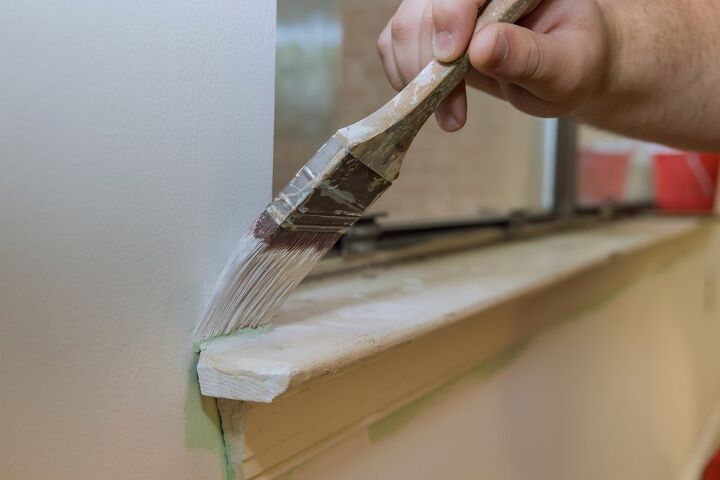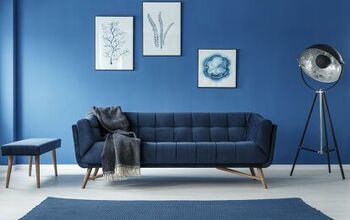Should You Paint Your Walls And Trim The Same Color?

When you paint your walls, there are several preparation steps you need to take first. You need to clean the walls and protect the floors, and then you have to consider the trim. Before you tape off your trim, you might want to ask yourself whether or not you can just paint your trim the same color as the walls.
You can absolutely paint walls and trim the same color. When you paint walls and trim the same color it cuts down on painting time, can make the space look bigger, and helps soften the angles in the room. It can make a bold color choice pop more, and is ideal if you are painting your walls white or if you are going for a minimalist look.
Regardless of which route you decide to take, you should know there are no hard rules or laws when it comes to painting your wall the same color as your trim. If you think painting the trim a different color looks better, go for it. If, however, you are on the fence, review these 10 reasons you should consider painting your walls and trim the same color before you make your final decision.
10 Reasons To Paint Walls And Trim The Same Color
1. It’s Easier To Paint And Touch Up
One big and practical reason you should consider painting your walls and trim the same color is it is easier to paint and touch up. For one, you are only using one paint color, rather than several. You can also do the project all at once, rather than having to tape off one section while you allow the other to dry, and vice versa. This cuts the price of painting your walls and trim down significantly.
2. If You Plan To Paint Your Walls White
If you are planning to paint your walls white, it might be a wise decision to just paint your walls and trim the same white. The most common color for trim is white, so you are essentially just matching the trim color to the wall. This makes for a much cleaner look than if you had two different and competing shades of white. If you paint your walls white and the trim a different color, you may find the trim gives a weird and jarring border effect.
3. Makes The Room Look Bigger And Taller
When you paint your walls and trim the same color it can also create the illusion that the room is bigger and taller than if you paint them different colors. As far as height, when you paint the trim a different color, you are essentially creating thick borders on the top and bottom of the wall. This shrinks the wall size and makes it look shorter than it is.
If, instead you paint the room a lighter neutral color, you can trick the eye into thinking the room is taller than it is, as the lines are less rigid and defined. This effect works well with lighter color in rooms with good light, but is a great idea for any smaller room in your home.
4. Helps Busy Trim Work Blend In With The Room
Sometimes you want to highlight your custom trim work, which is great. Other times the trim and molding is so busy that it takes away from other elements of the room. If you are looking to soften the effect of the busy trim work, it helps to paint it the same color as your walls. This makes it blend in with the walls, but allows it to still have an effect on the room, without losing its appeal.
5. Softens Angles In Large Busy Areas
If you have a room with lots of angles and elements, it might be a good idea to paint the walls and trim the same color. Areas like atriums near staircases and other places with harsh angles and lots of trim are examples of this.
If you paint the trim a different color, there may be so many distinct lines and angles that someone can get dizzy just from looking at it. When you paint the trim the same color, it softens the lines and angles.
6. Helps To Highlight Other Accents
If you have something in a room you want to feature, like an antique radiator or wooden accents, you don’t want the trim to compete for attention. The best way to highlight an element in the room that doesn’t involve the wall or trim is to paint them the same color. This allows the wall to be a blank canvas to feature other elements.
7. Allows For Bold Color Decisions
If you select a paint color because you want to make a bold splash, then you might as well go all the way. Try painting the wall and the trim the same bold color. This will help your color pop even more. Otherwise, you may find that the trim takes away from or boxes in that bold accent color.
8. Camouflages Your Built-In Carpentry Work
If you have custom-built cabinets or shelving, try painting them, along with the walls and trim, the same colors. This is a very helpful way to deceive the eye into making it all blend into the wall. This helps give a unified look to the room. It also can help elevate the look of your custom carpentry work (especially if it was a DIY project).
9. Creates A Seamless Harmonious Space
If you are looking for a room with simplicity and harmony, then you should think about painting the trim and walls the same color. Having one unified color gives a sense of balance and harmony in the room. Many people find softer and hidden angles more soothing than defined borders. If this is the feeling you are trying to promote, you should not run from it.
10. Great For A Minimalist Aesthetic
The minimalist lifestyle is becoming very trendy in interior design these days. This aesthetic involves lots of open space, no clutter, and only the necessary decor and furniture. If this is your vibe, you also may want to consider painting your walls and trim the same color.
The minimalist look often looks clean and dramatic (in a good way) when the backdrop is one color. Lines and different colored trim can make this modern approach look a bit dated and busy.
Why Wouldn’t You Paint Your Walls And Trim The Same Color?
With all these great reasons to paint your walls and trim the same color you might wonder if there are really any reasons why you shouldn’t. In reality, it is all about your personal taste and judgment.
One reason you wouldn’t want to paint your trim is if you have expensive and antique trim. If you want to highlight it, painting it in contrast to the wall color may be the way to go. Or if you have gorgeous natural wood trim in a home with an earthy tone (like a cabin) it would be a shame to cover that up.

Tom Gaffey is an expert writer who currently resides in Washington D.C. Tom has a passion for real estate and home improvement writing, as well as travel and lifestyle writing. He lived the last twelve years in Hawaii where he worked closely with luxury resorts and event planners, mastering his knowledge of aesthetics and luxury products. This is where he found his passion for home improvement and a keen interest in DIY projects. Currently, Tom resides in Washington D.C, and also working on his debut fiction novel.
More by Tom Gaffey












![How Much Weight Can a 4×4 Support Horizontally? [It Depends!]](https://cdn-fastly.upgradedhome.com/media/2023/07/31/9070333/how-much-weight-can-a-44-support-horizontally-it-depends.jpg?size=350x220)
![10 Best Scroll Saws for 2022 [Ultimate Reviews & Buyer's Guide]](https://cdn-fastly.upgradedhome.com/media/2023/07/31/9070684/10-best-scroll-saws-for-2022-ultimate-reviews-buyer-s-guide.jpg?size=350x220)

![12 Washing Machine Brands to Avoid [with Recall Data]](https://cdn-fastly.upgradedhome.com/media/2023/07/31/9075781/12-washing-machine-brands-to-avoid-with-recall-data.jpg?size=350x220)


![Standard Dining Room Table Dimensions [for 4, 6, 8, 10 and 12 People]](https://cdn-fastly.upgradedhome.com/media/2023/07/31/9074335/standard-dining-room-table-dimensions-for-4-6-8-10-and-12-people.jpg?size=350x220)








